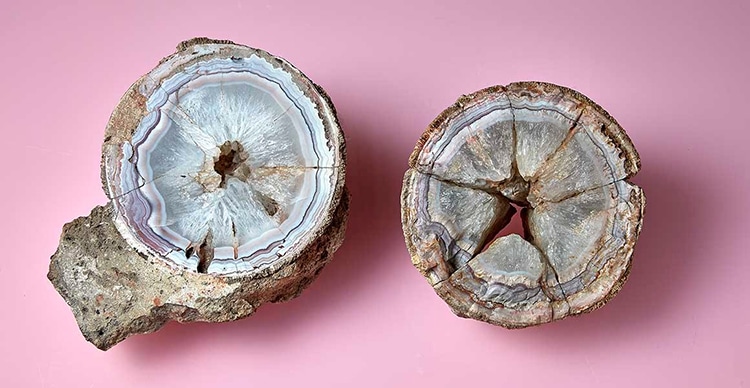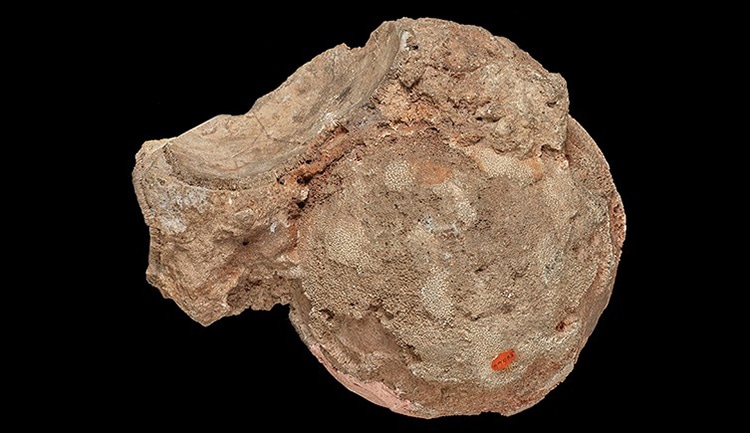
Agate crystals apparently grew inside a titanosaur egg. (Photo: Natural History Museum)
A beautiful pink and white agate crystal has sat in the archives of London’s Natural History Museum since 1883. In 2018, a minerals curator named Robin Hansen selected the pretty stone to display at the institution. Several months later, Hansen encountered a similar agate, which a dealer informed him was in fact an agatized dinosaur egg. Realizing what he might have discovered, Hansen and museum staff have since confirmed the rock is in fact a dinosaur egg which has filled with agate crystal over the course of millions of years.
“While I was looking around the show, a dealer showed me an agatized dinosaur egg, which was spherical, had a thin rind, and dark agate in the middle,” Hansen said in a statement. “That was the lightbulb moment when I thought: ‘Hang on a minute, that looks a lot like the one we’ve just put on display in the Museum!’” Museum paleontologists Professor Paul Barrett and Dr. Susannah Maidment took a look. They noted that the “rock” had an external texture that resembled that of a dinosaur egg. It was also the size (15 cm / 5.9 inches across) and spherical shape of a titanosaur egg. Titanosaurs were a group of four-legged, long-necked dinosaurs who roamed across the world in the Cretaceous period.
Further tests with CT scans were unhelpful due to the dense rock material. However, pressed into the surface are marks indicating the object lay next to others of similar size and shape. These factors all hint at the surprising truth. Additionally, the object is thought to be about 67 million years old. It was discovered in India by Charles Fraser between 1817 and 1843. India is rich in titanosaur fossils, although other species of dinosaurs were unrepresented on the ancient, then-island landmass. Researchers are convinced by the resemblance of the “agate” to a titanosaur egg, even though its 19th-century discoverers would not yet have recognized it as such.
So how did a fossilized dinosaur egg become filled with agate crystals? Scientists suspect the titanosaur mother may have laid her clutch of eggs on top of warm volcanic soil for incubation, but a volcano may have blanketed the eggs before they could hatch. Basalt rock would have formed around the egg shells, the material inside eventually rotting away. According to the museum, from this accident of fate, “silica-rich water must have repeatedly percolated through the rock and the shell of the egg. This filled the void, creating the banded agate specimen that was eventually dug up tens of millions of years later.” The end result is a surprising, beautiful artifact that unites both mineralogy and paleontology.
The Natural History Museum has possessed a beautiful spherical agate for over a hundred years, only to recently discover it is in fact a fossilized titanosaur egg filled with crystals.

The surface retains the dinosaur egg’s texture. (Photo: Natural History Museum)
The egg was likely fossilized by lava and filled slowly with crystals over millions of years.

An example of a titanosaur, in this case a Ampelosaurus atacis. (Photo: Wikimedia Commons, Public domain)
h/t: [IFL Science]
Related Articles:
Scientists Discover the Oldest Peltoperleidus “Bony Fish” Fossil Ever in China
World’s Oldest Preserved Brain Found in a 319 Million-Year-Old Fish Fossil
Paleontologists Discover Fossil of an Enormous 340-Pound Penguin in New Zealand
Fossil of Ancient Giant Sea Turtle the Size of a Rhino Discovered in Spain
